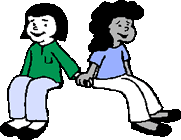TEACHING SOCIAL SKILLS1 Life is not a popularity contest, but your children will require reasonable social skills to get along in families, schools and in the workplace. Although parents should be taking the major responsibility for teaching those skills to their kids, teachers will automatically be involved in guiding social skills in classrooms and school hallways. Other adults, peers and the media also dramatically affect children in their social interactions. Here are some foundational suggestions for teaching your children social skills. EARLY SOCIAL SKILLS - Beginning basic social skills teach children to interact with other children and adults. Sharing is probably one of the most difficult ones to learn since young children are so egocentric. By age two the word “mine” becomes important in their thinking, actions and vocabulary. Children have to learn to share attention, time, talk and toys. Because young children can’t put themselves in other’s places yet, they learn this sharing by simple rules like “take turns,” “raise your hand before you talk,” “form a line,” “don’t hit, kick or bite,” “use your words,” “use good manners,” “follow the teacher’s instructions,” “be kind,” “choose an activity or toy to play with,” “put your toys away,” etc. These only name a few behavioral instructions that children will hear in their daycare, preschools and primary grades, but in preparing children for social environments, parents need to teach these skills at home to help young children feel more comfortable in social environments. Young children also need to learn appropriate assertiveness skills. These are more difficult to teach and harder to learn. Asking a teacher if they can use the bathroom, do a different activity, play with another child or requesting that a child share a toy, play with them, or not touch, hit or take a toy away from them are social skills that children must learn to initiate. In order for children to learn to be assertive, parents will have to resist doing too much for them, or they won’t learn to speak up for themselves. Children who feel comfortable with these rules and confident with assertive skills feel more self-assured in their school world and with their friends. You’ll need to be patient. These skills are not automatic, and children only learn them gradually. If they learn them well, they’ll be better prepared for the later social skills that involve much more in depth understanding of others in their world. THE FOUR R's FOR TEACHING During the preschool and primary grades, because children THE BASICS FOR TWEENS AND TEENS The social skills for tweens and teens become increasingly complex. Communication, collaboration and competition are crucial. Kids also need to learn sensitivity and resilience, kindness and assertiveness, empathy and humor, independence and appropriate conformity, and how to become interested and interesting. Same-gender friendships continue, but relationships with the opposite sex become increasingly important. Peer pressures extensively affect children's social skills during these years, and parental controls decrease as children have more freedom and choices. TEACHING LATER SOCIAL SKILLS P Listening to your kids and their friends, sharing life experiences and being supportive become your most important tools. This is an important time for parents to play their leadership roles as coaches instead of judges. Guiding without continuous criticism is tricky, but more effective. Plenty of conversation while doing things together helps prevent the lecture format. Game playing, including board, card, outdoor games and even walking or hiking, increases opportunities for personal communication and fun. With it all, you have to state your values clearly and know that children hear what you say, even when they roll back their eyes. The tween years may indeed be more difficult socially than the teen years because of the peer pressure for popularity and conformity. My book, Growing Up Too Fast: The Rimm Report on the Secret Lives of America's Middle Schoolers, provides lots of help with the needs of middle schoolers. While they may appear to be socially sophisticated beyond their years, their questions and worries remain preadolescent. They require your help and limits, but are less likely to ask for them than in earlier generations. High school is further complicated by alcohol, drugs and sexual promiscuity that go far beyond what parents remember in their own teen years. These high-risk activities are so prevalent that they cause healthy teens who aren't involved to feel isolated, different and lonely at times. Teen’s best protection is their involvement in interests and activities that provide them with positive peers that share their values. They may resist your guidance or in contrast, sometimes beg for help, and you may struggle in determining how much freedom and guidance to give them as they navigate their social searches. Discover opportunities, retreats and summer camps that are socially hospitable and will help them build self-esteem, and support them as they find their identities and discover their exciting world.
1Excerpts from Dr. Sylvia Rimm’s book Growing Up Too Fast: The Rimm Report on the Secret Lives of America’s Middle Schoolers (2005). ©2012 by Sylvia B. Rimm. All rights reserved. This publication, or parts thereof, may not be reproduced in any form without written permission of the author. |
||
©2010 by Sylvia B. Rimm. All rights reserved.
Report any problems with this site to Webmaster@sylviarimm.com

 are very concrete in their thinking, you’ll need to guide them with four R’s – Repetition, Rewards, Role-plays and Reading. Parents may wonder how many times they’ll have to repeat their reminders to their little ones to say please and thank you before those words become automatically attached to their requests and their appreciations. Perhaps it will take several thousand repetitions before your children proceed in the world with good manners.
are very concrete in their thinking, you’ll need to guide them with four R’s – Repetition, Rewards, Role-plays and Reading. Parents may wonder how many times they’ll have to repeat their reminders to their little ones to say please and thank you before those words become automatically attached to their requests and their appreciations. Perhaps it will take several thousand repetitions before your children proceed in the world with good manners.  arents and teachers are no longer the only teachers. Kids look toward peers and the media for social lessons. They imitate television and music role models as well as their peers, but caring parents and teachers continue to play a crucial role in guiding their kids, so don't give up on your important leadership. There are still the 4 R's. Kids may now call your repetition, nagging or lecturing. Your praise continues to reward your kids, but they seem more ambiguous in their response. Role-playing can continue to be very effective with tweens and teens, and there are many excellent self-help books that kids can select and read to themselves. Magazines provide plenty of social-skill information as well, but you may not approve of all their messages.
arents and teachers are no longer the only teachers. Kids look toward peers and the media for social lessons. They imitate television and music role models as well as their peers, but caring parents and teachers continue to play a crucial role in guiding their kids, so don't give up on your important leadership. There are still the 4 R's. Kids may now call your repetition, nagging or lecturing. Your praise continues to reward your kids, but they seem more ambiguous in their response. Role-playing can continue to be very effective with tweens and teens, and there are many excellent self-help books that kids can select and read to themselves. Magazines provide plenty of social-skill information as well, but you may not approve of all their messages.  Each generation of educators and parents copes with the dilemma of determining the approaches of kids’ clothes for school, dress-up, casual and beachwear. Fashions keep changing so that tight, loose, short, long, flared, or straight styles or exposed shoulders and navels seem to vacillate between generations. While there are always variations, the current fashion of spaghetti straps, bared navels and drooping pants accompanies the earlier interest in sexuality displayed by kids. Thus, the guidelines and arguments may also begin earlier.
Each generation of educators and parents copes with the dilemma of determining the approaches of kids’ clothes for school, dress-up, casual and beachwear. Fashions keep changing so that tight, loose, short, long, flared, or straight styles or exposed shoulders and navels seem to vacillate between generations. While there are always variations, the current fashion of spaghetti straps, bared navels and drooping pants accompanies the earlier interest in sexuality displayed by kids. Thus, the guidelines and arguments may also begin earlier.